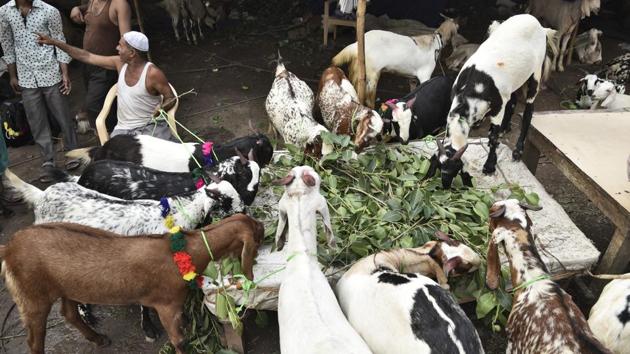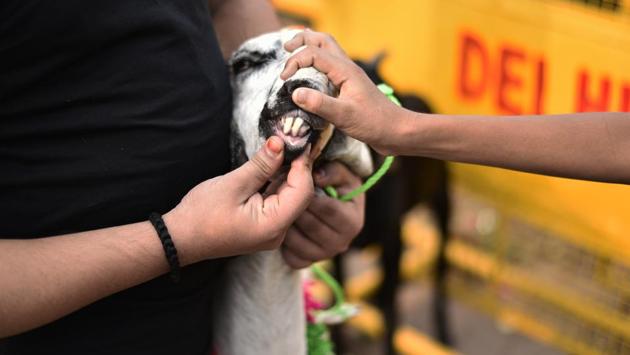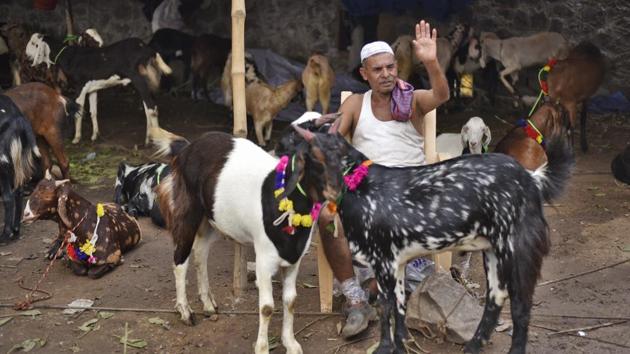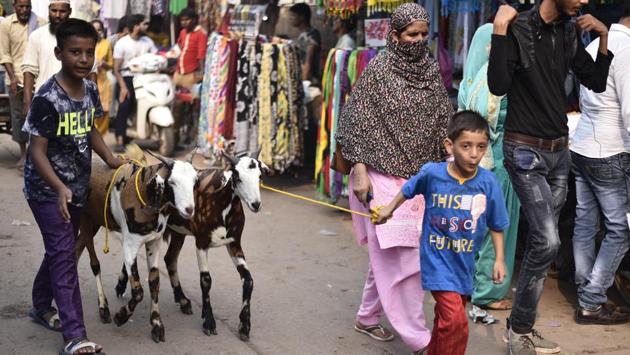Photos: Eid al-Adha brings alive Jama Masjid’s goat market
Updated On Aug 31, 2017 12:22 PM IST
Eid al-Adha, popularly known as ‘Bakri Eid’ in the subcontinent is slated for September 2nd this year. The goat market of Jama Masjid in Old Delhi is abuzz with traders looking for customers to sell their goats as part of the traditional sacrificial ritual commemorating the obedience of Islamic prophet Abraham to God.
1 / 8

Updated on Aug 31, 2017 12:22 PM IST
Eid al-Adha, popularly known as ‘Bakri Eid’ in the subcontinent is slated for September 2nd this year. The market surrounding the Jama Masjid have been abuzz with traders looking for customers to purchase goats ahead of Eid --a commemoration that involves a sacrifice to honour the legacy of the Islamic prophet Abraham who according to tradition was willing to sacrifice his son Ishmael as an act of obedience to God when the angel Gabriel intervened and instead replaced his son with a ram. (Vipin Kumar/HT PHOTO)
2 / 8

Updated on Aug 31, 2017 12:22 PM IST
Also known as the ‘sacrificial feast’, the second Eid of the year will be celebrated worldwide from the evening of September 1. Eid al-Adha as per the lunar calendar begins on the tenth day of Dhu’l-Hijjah, the final month of the Islamic calendar. This Eid falls after the Arafat Day of the annual Hajj pilgrimage to the holy cities of Mecca and Medina in Saudi Arabia, a journey obligatory upon all abled Muslim men and women once in their lifetime. (Burhaan Kinu/HT PHOTO)
3 / 8

Updated on Aug 31, 2017 12:22 PM IST
According to the chief imam at the All India Imam Organization, the goats on sale for the occasion of Bakri Eid must be without blemish and that the animal should be strong and healthy at the time of the sacrifice. The slaughter is further done by specially trained Islamic butchers and the recitation of verses. during this period, fuelled by exorbitant demand, the prices for goats can range vastly from Rs 3,000 to over Rs 1 lakh. (Vipin Kumar/HT PHOTO)
4 / 8

Updated on Aug 31, 2017 12:22 PM IST
The goats are minutely inspected must be healthy to be deemed fit for sacrificial purposes. The physical structure of the goat should have uniformity especially along the back of the goat, also called loin --considered the most prized cut of meat. The loin extends from the ribs and runs through the top of the back, both sides of the spine to the rump. (Vipin Kumar/HT PHOTO)
5 / 8

Updated on Aug 31, 2017 12:22 PM IST
A structural deformity in the jaw could mean hereditary conditions, making it unfit for sacrifice. The goat’s lower teeth should perfectly flush with the upper dental pad when it closes its mouth which is examined by lifting the jaw and counting the number of teeth - another metric for choosing a fit and able animal for sacrifice. (Burhaan Kinu/HT PHOTO)
6 / 8

Updated on Aug 31, 2017 12:22 PM IST
Many of the goats tethered in the market have synthetic and decorative flowers and items strapped around their neck to attract customers. Sales have reportedly dipped this season post demonetisation which affected the traders’ ability to adequately feed their livestock and raise them to much larger sizes which attract higher sums in the Eid period. (Burhaan Kinu/HT PHOTO)
7 / 8

Updated on Aug 31, 2017 12:22 PM IST
However, doubt looms over the sale of the animals among traders this year owing to fear of ‘gau rakshaks’, preventing them from transporting goats to bigger cities from the hinterlands where they are bred, providing sellers far higher returns compared to local markets. (Vipin Kumar/HT PHOTO)
8 / 8

Updated on Aug 31, 2017 12:22 PM IST



